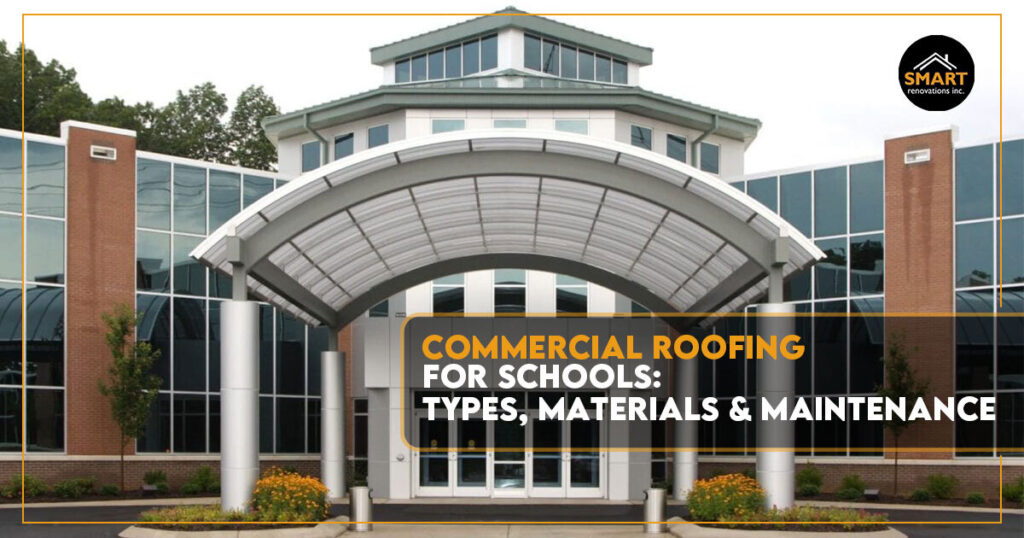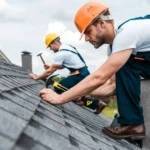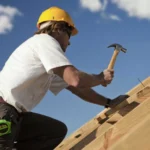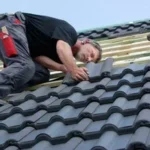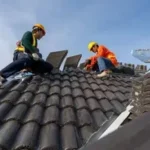Schools and other institutions in particular need roofing solutions that can withstand a great deal of wear and tear and still remain efficient when it comes to energy consumption, as well as not be too expensive to implement. Of course, the roofs of schools, colleges, and other learning institutions differ in their requirements depending on the geographical location, the construction type, or purpose of the building. Knowledge of the various roofing systems available on the market and factors related to construction as well as maintenance and commercial roof repairs is essential to ensuring an adequate and safe learning environment.
1. Types of Roofing Systems for Educational Institutions
There is a variety of roofing solutions for educational institutions, and each option has its strengths and weaknesses. Here are some of the most common roofing systems used:
- Flat Roofs: Educational institutions often choose for flat roof buildings due to its affordability and ease of installation of systems like air conditioning. Flat commercial roofing is prone to water logging and requires continual monitoring and maintenance to prevent water seepage and subsequent issues.
- Shingle Roofs: Asphalt shingles are ideal for small schools or the administrative blocks of larger institutions. They tend to have a more traditional appearance and are fairly simple to fit. While they are long-lasting, shingles may be more prone to some levels of maintenance, especially after being subjected to harsh weather.
- Metal Roofs: Schools are increasingly opting for metal roofs due to their durability and weather resistance. Though more expensive to install, they are energy-efficient and protect well. Inspections and commercial roof repairs will extend their lifespan.
- Slate Roofs: Add aesthetic appeal to historical or famous educational institutions. They are extremely resilient and can survive a century. Keeping them in good condition requires skilled care and high initial fees.
- Green Roofs: Green roofs are an eco-friendly solution that involves putting plants on the roof surface. Stormwater discharge is reduced by insulation. Green roofs are hard to set up but require special upkeep and boost building energy efficiency.
2. Roof Construction Process for Educational Buildings
Roofing is an important part of construction, especially for educational facilities; therefore, it is a very delicate kind of work. Regardless of whether it is a new installation or a replacement project, each of the steps must be handled by professionals in order to avoid any catastrophes, to attain the highest levels of durability and to adhere to all of the appropriate codes that govern the construction of buildings.
- Assessment and Planning: Contractors must evaluate the building’s structure and choose the best roofing system before starting construction. Climate, building architecture, and roof longevity are addressed.
- Material Selection: Consider budget, environmental issues, and institution demands while selecting roofing materials. Schools may choose metal, shingles, or green roofs based on their needs.
- Installation: Roofing installations for educational buildings often occur during school breaks to avoid interruptions. Insulation, waterproofing, and the roofing material are usually installed.
- Inspections and Quality Control: Regular inspections and quality control are crucial throughout construction to guarantee the roof fulfills safety and quality requirements. Poor installation can cause costly leaks and structural damage, requiring regular commercial roof repairs.
3. The Importance of Regular Maintenance and Upkeep
Maintaining the lifetime of the roofing system and guaranteeing the safety of staff and students depends on continuous maintenance once it is in place. Regular maintenance helps to avoid little problems from becoming more major, costly ones.
- Routine Inspections: Regular roof inspections, especially after severe weather occurrences, are recommended for educational facilities. Professional contractors can spot broken shingles, pooled water on flat roofs, and rust on metal roofs. Catching these issues early can prevent severe commercial roof repairs.
- Cleaning and Debris Removal: Regular roof cleaning includes removing debris such as leaves, branches, and dirt to prevent drainage system blockages and surface damage. Water buildup from clogged gutters causes leaks in flat and low-slope roofs.
- Weatherproofing: Weatherproofing materials on roofs may degrade over time, particularly in harsh temperatures. Reapplying waterproof coatings or sealants prolongs roof life and prevents leaks. Flat roofs are prone to water collection and require more regular commercial roof repairs, therefore weatherproofing is crucial.
- Addressing Leaks Promptly: A little roof leak can become a significant issue if not treated promptly. Water entry can damage the facility, develop mold, and disturb teaching. Schools must have a plan for quick commercial roof repairs to minimize damage.
Also check out these:
Innovations in Commercial Roof-Mounted Solar Power Systems
Optimizing Natural Light: Skylights and Day lighting Systems
4. How Commercial Roof Repairs Save Costs
Over time, proactive maintenance and prompt commercial roof repairs can save educational institutions a lot of money. Although postponing repairs could help to save money, usually this results in more costly issues later on.
- Preventing Structural Damage: Ignoring roof leaks or broken shingles can lead to interior water damage, affecting walls, ceilings, and electrical systems. Early commercial roof repairs prevent serious structural damage, which is more expensive to restore.
- Increasing Roof Longevity: Regular maintenance and repairs prolong the lifespan of the roofing system, preventing commercial roof replacement cost. Quality roofing systems like slate and metal need occasional repairs to last.
- Improving Energy Efficiency: A well-maintained roof helps improve the building’s energy efficiency by preventing air leaks and reducing the strain on HVAC systems. This can lead to lower utility bills and a more comfortable environment for students and staff.
Conclusion
Roofing system is one of the crucial structures that facilitate safety, comfort and functionality of an educational institution building. Starting from choosing the most appropriate materials to employing the right approach when it comes to roofing inspection, each step contributes to creating a long lasting roofing system. Catching them early and doing proper maintenance on a commercial roofing system will help reduce the need for commercial roof repairs in the future. Schools, colleges, and other institutions should hire professional roof contractors to ensure that their roof is always well maintained to give the institutions a secure and more energy-efficient environment in which the students can study.
Check our google store: Smart Renovation

